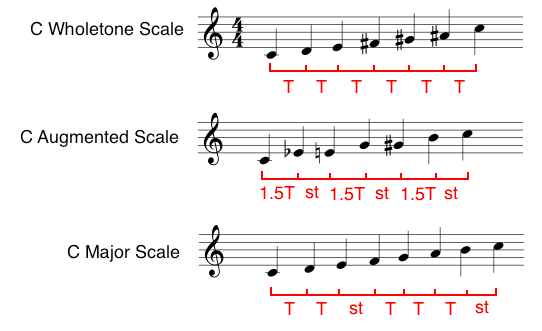Introduction
We have already encountered some Symmetrical Scales in the previous Jazz Scales module, but it worth discussing Symmetrical Scales in general.
Symmetry & Structure
In the previous lesson on Cycled Patterns, we learned that music must be ‘structured’ and that there are at least two ways of structuring music:
- A structure based on keys and diatonic scales and chords; or
- A structure based on patterns.
Structure based on keys and diatonic scales feels like it is moving towards some ultimate tonic chord (i.e. functionality). While structure based on patterns does not feel like it has any kind of root note or tonic chord (i.e. non-functional).
Symmetrical Scales
Well, symmetrical scales fall under the latter category and are therefore non-functional (we will learn much more about functionality in future lessons). They divide an octave into equal intervals and follow a intervalic pattern both up and down the scale. They do NOT sound like they have fixed root note precisely because they are symmetrical – unlike the Major Scale. Because symmetrical scales are constructed from repeating interval patterns, each ‘mode’ of a symmetrical scale sounds the same as (or very similar to) all the others.
- C Chromatic sounds like C# Chromatic sounds like D Chromatic sounds like…etc.
- G Wholetone sounds like A Wholetone sounds like B Wholetone sounds like…etc.
- C H/W Diminished sounds like D# H/W Diminished sounds like F# H/W Diminished sounds like…etc.
- Whereas C Major sounds very different to D Dorian which sounds very different to to E Phrygian which sounds…etc.

This means symmetrical scales sound much more ambiguous and atonal compared to the Major Scale. This makes them a great technique to include in your solo, as it allows you to play outside notes in a structured way (following a repeating pattern, similar to cycled patterns, but in the form of a scale) and thus build tension in your solo.
Below is a list of some symmetrical scales you can use.
| Scale | Intervals | Notes from C |
|---|---|---|
| Chromatic | All st | C D♭ D♮ E♭ E♮ F G♭ G♮ A♭ A♮ B♭ B♮ |
| Wholetone | All T | C D E G♭ A♭ B♭ |
| H/W Diminished | st, T, st, T, etc. | C D♭ D# E F# G A B♭ |
| W/H Diminished | T, st, T, st, etc. | C D E♭ F G♭ A♭ A B |
| Augmented Scale | 1.5T, st, 1.5T, st, etc. | C E♭ E G G# B |
| Tritone scale | st, 1.5T, T, st, 1.5T, T, etc. | C D♭ E G♭ G♮ B♭ |
| Two-semitone tritone scale | st, st, 2T, st, st, 2T, etc. | C D♭ D F# G A♭ |
Where st = Semitone; and T = Tone